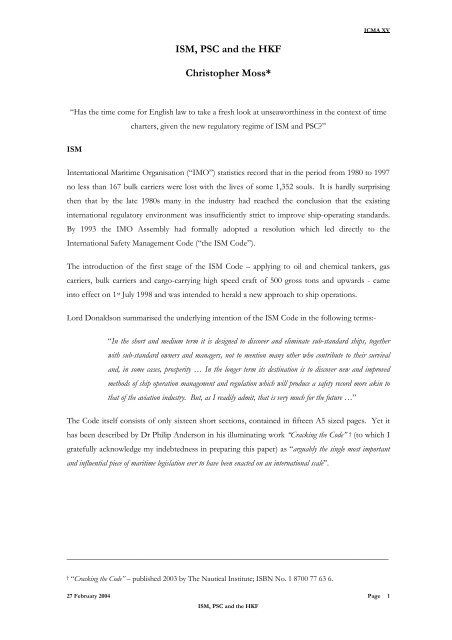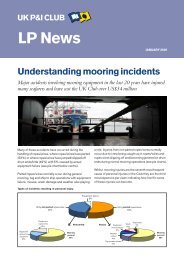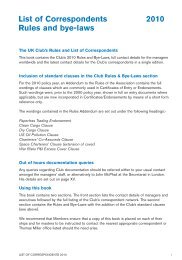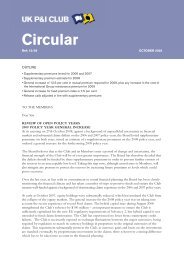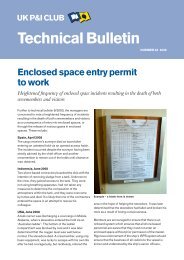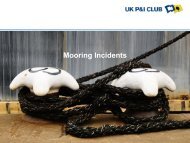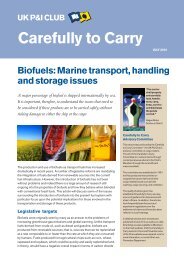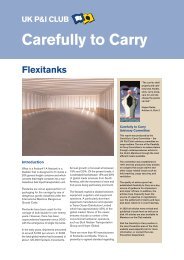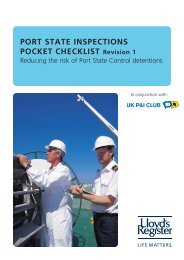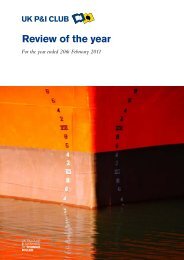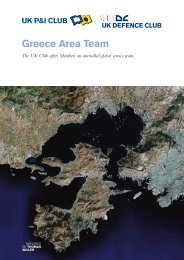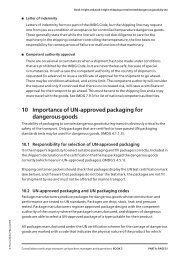55 Moss C
55 Moss C
55 Moss C
You also want an ePaper? Increase the reach of your titles
YUMPU automatically turns print PDFs into web optimized ePapers that Google loves.
ICMA XV<br />
ISM, PSC and the HKF<br />
Christopher <strong>Moss</strong>*<br />
“Has the time come for English law to take a fresh look at unseaworthiness in the context of time<br />
charters, given the new regulatory regime of ISM and PSC?”<br />
ISM<br />
International Maritime Organisation (“IMO”) statistics record that in the period from 1980 to 1997<br />
no less than 167 bulk carriers were lost with the lives of some 1,352 souls. It is hardly surprising<br />
then that by the late 1980s many in the industry had reached the conclusion that the existing<br />
international regulatory environment was insufficiently strict to improve ship-operating standards.<br />
By 1993 the IMO Assembly had formally adopted a resolution which led directly to the<br />
International Safety Management Code (“the ISM Code”).<br />
The introduction of the first stage of the ISM Code – applying to oil and chemical tankers, gas<br />
carriers, bulk carriers and cargo-carrying high speed craft of 500 gross tons and upwards - came<br />
into effect on 1 st July 1998 and was intended to herald a new approach to ship operations.<br />
Lord Donaldson summarised the underlying intention of the ISM Code in the following terms:-<br />
“In the short and medium term it is designed to discover and eliminate sub-standard ships, together<br />
with sub-standard owners and managers, not to mention many other who contribute to their survival<br />
and, in some cases, prosperity … In the longer term its destination is to discover new and improved<br />
methods of ship operation management and regulation which will produce a safety record more akin to<br />
that of the aviation industry. But, as I readily admit, that is very much for the future …”<br />
The Code itself consists of only sixteen short sections, contained in fifteen A5 sized pages. Yet it<br />
has been described by Dr Philip Anderson in his illuminating work “Cracking the Code” † (to which I<br />
gratefully acknowledge my indebtedness in preparing this paper) as “arguably the single most important<br />
and influential piece of maritime legislation ever to have been enacted on an international scale”.<br />
_____________________________________________________________________________<br />
† “Cracking the Code” – published 2003 by The Nautical Institute; ISBN No. 1 8700 77 63 6.<br />
27 February 2004 Page<br />
ISM, PSC and the HKF<br />
1
ICMA XV<br />
The approach adopted by the ISM Code is controversial. Its approach is essentially philosophical.<br />
At its heart is the Safety Management System (“SMS”) which must be set up by every ship<br />
operating company to which it applies. Yet the Code does no more than set out the component<br />
parts of a SMS and give broad indications of what constitutes proper management. It does not<br />
prescribe any absolute standards, nor does it state how its objectives are to be achieved. In essence,<br />
all that it provides is that every company to which it applies must obtain a Document of<br />
Compliance (“DOC”) and each of the ships which it is operating must obtain a Safety Management<br />
Certificate (“SMC”). Any company to which it applies must appoint a ‘designated person’, who<br />
must have access to the highest level of the company’s management and be closely involved with<br />
putting the SMS into practice.<br />
It is the fact that there is no recognised pro-forma SMS which can be used either to formulate the<br />
SMS for a particular operating company, or to judge the adequacy of any SMS when it is in force,<br />
that has led to criticism of the ISM Code. The original intention was that individual operating<br />
companies would be given the scope to produce a SMS which was appropriate to the particular<br />
requirements of the particular company and the vessels which it operated. Doubtless certain<br />
features will emerge in time as standard for companies operating particular types of vessel. For the<br />
time being I can do no better than quote Dr Anderson in “Cracking the Code” when he says that<br />
“describing a good, working, dynamic SMS may be as difficult as describing an elephant – but like an elephant, once<br />
one has seen one, it is easily recognised when encountered subsequently”.<br />
PSC<br />
The origins of Port State Control (“PSC”) lie as far back as the 1929 SOLAS Convention, but it<br />
was only with an agreement between eight North Sea states in 1978 that the concept of regional<br />
port state control agreements began its modern course of development.<br />
There are seven Memoranda of Understanding (“MOU”), each relating to regional groupings of<br />
port states (such as those covering Mediterranean or Indian Ocean states, for example). Although<br />
the USA remains outside any regional MOU grouping and undertakes control measures on a<br />
unilateral basis, there is now essentially a worldwide regulatory regime governing PSC.<br />
Detailed consideration of the workings of the PSC regime are outside the scope of this paper. The<br />
IMO has promulgated guidance as to how PSC inspections should be conducted and as to how<br />
deficiencies in a ship, its equipment or its crew are to be identified. Although these are not<br />
mandatory, they form the basis of the procedures adopted by most regional groupings of port<br />
states.<br />
27 February 2004 Page<br />
ISM, PSC and the HKF<br />
2
ICMA XV<br />
A Port State Control Officer (“PSCO”) will inspect a vessel to ensure that she complies with the<br />
requirements of all relevant international conventions. If a particular vessel is found to be noncompliant,<br />
the PSCO may require the deficiencies noted to be rectified before allowing her to sail.<br />
Alternatively, he can clear a vessel to sail on condition that the deficiencies are rectified either at a<br />
named ‘repair’ port or within a specified period of, say, fourteen days.<br />
A further international convention of relevance, the International Ship and Port Facility Security<br />
Code (“ISPS”), comes into force on 1 st July 2004. The powers given to Port States under the ISPS<br />
Code extend to the waters of the port approaches. Vessels intending to enter a foreign port may be<br />
required to submit security-related information to the Authorities ashore before they are cleared to<br />
enter that port. Thus, the process of inspection under PSC will in future start even before a vessel<br />
comes alongside in the port.<br />
The PSCO will seek to establish that a particular vessel is complying with the ISM Code at an early<br />
stage of his inspection. On the face of it, the industry therefore now has both the theoretical basis<br />
(in the ISM Code itself) and the practical means of ensuring compliance with higher standards (in<br />
the PSC regime) so that we should all be able to look forward with confidence to a process of<br />
steady improvement in ship operating standards - and an end to the sequence of maritime disasters<br />
(from the “Herald of Free Enterprise” in 1987 to the “Exxon Valdez” in 1989 to the “Aegean Sea” in<br />
1992 and the “Estonia” in 1994 – to name but a selection) of recent times.<br />
The HKF<br />
The leading authority on unseaworthiness in the context of time charterparties under English law is<br />
the decision of the Court of Appeal in The “Hong Kong Fir” [1961] 2 Lloyds Rep 478 (“the<br />
HKF”). If ever an illustration were needed of the maxim that ‘hard cases make bad law’, it is surely<br />
this case. Delivery into service under a 24-month time charter took place on 13 th February 1957.<br />
The vessel proceeded from Liverpool to Newport News to Cristobal - and then set off for Osaka.<br />
Having been off-hire due to engine breakdowns for approximately thirteen days thus far, she was<br />
then obliged to put into San Pedro (near Los Angeles) as a port of refuge. There she was off-hire<br />
for a further period of almost 23 days. When she finally arrived at Osaka on 15 th May 1957 she<br />
broke down – yet again – and was not ready for sea until 15 th September, further repairs having<br />
been carried out to her main engine and auxiliaries as a result of the fact that she was found to be in<br />
“a very bad state due chiefly to corrosion”.<br />
According to my rough and ready calculations, these events can be summarised in the statement<br />
that from the time of delivery at Liverpool until arrival at Osaka she been at sea for about eight and<br />
half weeks, had been off-hire for about five weeks, and by the time that she was ready for further<br />
service following completion of repairs at Osaka, approximately 20% of the entire value of the<br />
vessel herself had been spent on repairs – all in this short period.<br />
27 February 2004 Page<br />
ISM, PSC and the HKF<br />
3
ICMA XV<br />
The case was made the more memorable by the fact that Mr Justice Salmon at first instance found<br />
that the Chief Engineer was a “hopeless drunkard” and described the second engineer as someone<br />
“not having much enthusiasm for hard work”. Despite the fact that the vessel had no less than five<br />
engineers, three fitters and seven greasers as her engine room staff, they were found to be<br />
insufficient in numbers – as well as incompetent!<br />
The Court of Appeal upheld the decision of Mr Justice Salmon who (astonishingly – to me at least)<br />
had concluded that the owners’ breaches of their obligations with regard to the seaworthiness of<br />
the vessel were not sufficiently serious as to amount to a repudiation of the charterparty. The<br />
charterers were not therefore entitled to terminate the charterparty for repudiatory breach, as they<br />
had done. The underlying reasoning of the Court was that the delays which had the vessel had<br />
suffered were not such as to deprive the charterers of substantially the whole of the benefit of the<br />
use of the vessel under the charterparty.<br />
It is, of course, a fundamental principle of English law that the sanctity of contracts must be upheld<br />
whenever possible. It was also thought by some to be the case in earlier days that English maritime<br />
law generally inclined towards sympathy with shipowners rather than charterers (Britain being in<br />
former times a leading ship-owning nation). Whether such considerations subconsciously affected<br />
the English Courts of an earlier period or not, the decision in the HKF proved to be the<br />
foundation of a line of authority in English law which I would argue has made it almost impossible<br />
for Courts or arbitrators to conclude that even the most obvious unseaworthiness of a vessel can<br />
entitle a charterer to terminate a time charterparty.<br />
The justification for this position is usually put on the basis that the obligation of seaworthiness in<br />
English law is so wide-reaching that it may easily be breached in ways which are comparatively<br />
trivial. If unseaworthiness in itself were viewed as a ground for termination of a time charter, it<br />
could mean (so it is argued) that a charterer was entitled to terminate for minor breaches which had<br />
little or no significance in terms of the ability of the charterer to use a particular vessel profitably.<br />
The “HERMOSA”<br />
The other leading case in English law, which built on the foundations established in the HKF, was<br />
that of The “Hermosa” [1980] 1 Lloyds Rep 638, a decision of Mr Justice Mustill.<br />
The vessel was time chartered for a minimum period of two years and sub-chartered on the same<br />
terms for a similar period. Serious cargo damage was sustained on her first voyage as the result of<br />
unseaworthiness in December 1974. Repairs were carried out from mid-January to the end of<br />
March 1975, as a result of which the sub-charterers lost their intended next employment for the<br />
vessel.<br />
27 February 2004 Page<br />
ISM, PSC and the HKF<br />
4
ICMA XV<br />
The owners had refused the sub-charterers permission to have the ship surveyed after the first<br />
voyage but eventually, in August 1975, the sub-charterers obtained a Court order permitting them<br />
to do so. The result of their survey was to establish the fact that the deficiencies in the vessel’s<br />
hatch covers which had caused the damage to cargo on the first voyage remained unrepaired. The<br />
condition of the vessel was also criticised in other respects.<br />
The head charterers (responding from to an ultimatum from the sub-charterers) were unable to<br />
obtain any reassurances from the owners that they were attending to these defects. The subcharterers<br />
then terminated the sub-charter. Unfortunately for the sub-charterers, the owners had<br />
arranged for the repair of these defects prior to the termination of the sub-charter in August 1975<br />
and the repairs were indeed completed by the end of October 1975.<br />
Mr Justice Mustill concluded that the sub-charterers had not been justified in treating the charter as<br />
discharged by reason of the vessel’s unseaworthiness because the defects which still existed were<br />
capable of being remedied within a relatively short time, which would have left 16 to 20 months of<br />
the charter to run. That view was upheld by Lord Justice Donaldson when the case went to the<br />
Court of Appeal. Mr Justice Mustill had taken the view that the sub-charterers had been justified<br />
in their suspicions that the hatch covers might not be properly repaired but he nevertheless held<br />
that this was insufficient to justify the termination of the sub-charter because the conduct of the<br />
head charterers was not regarded as being such as to lead a reasonable person to conclude that they<br />
did not intend to fulfil their contractual obligations.<br />
The decision in that case was complicated by the fact that the charter terminated was a sub-charter<br />
and it was clearly the case as a matter of basic legal principle that the conduct of the owners<br />
themselves could not necessarily be taken as the conduct of the head charterers in such a situation,<br />
so as to justify the termination of a time charterparty. Although both Courts followed the ‘HKF<br />
line’, the judgment of Mr Justice Mustill contained the following interesting passage:-<br />
“Finally, there is the argument of Nitrates [the sub-charterers] that it is permissible to add together the<br />
actual breaches and the conduct which threatened further breaches in the future to yield the state of<br />
affairs amounting to a repudiation, even if the individual elements were not in themselves repudiatory.<br />
Whether actual and anticipated breaches can be treated as cumulative in this way has yet to be decided.<br />
I need say nothing about the matter here. I have rejected the argument on renunciatory breach, not<br />
because the breach with Nitrates anticipated was insubstantial, but because the conduct of MTC [the<br />
head charterers] and the owners did not justify a firm inference that there would be a further breach.<br />
This being so, there is nothing to add to the actual breaches which had already occurred.”<br />
I venture to suggest that in this passage Mr Justice Mustill may have been recognising, impliedly at<br />
least, the injustice which could result from a strict application of ‘the HKF line’ on unseaworthiness<br />
in the context of time charterparties.<br />
27 February 2004 Page<br />
ISM, PSC and the HKF<br />
5
ICMA XV<br />
The Way Ahead<br />
The initial reaction of charterers has been to protect themselves against the consequences of noncompliance<br />
with the ISM Code by including in charterparties clauses such as the “BIMCO ISM<br />
clause” - which reads as follows:-<br />
“From the date of coming into force at the International Safety Management (ISM) Code in relation<br />
to the vessel and thereafter during the currency of this Charter Party, the Owners shall procure that<br />
both the vessel and ‘the company’ (as defined by the ISM Code) shall comply with the requirements of<br />
the ISM Code.<br />
Upon request the Owners shall provide a copy of the relevant Document of Compliance (DOC) and<br />
Safety Management Certificate (SMC) to the Charterers.<br />
Except as otherwise provided in this Charter Party, loss, damage, expense or delay caused by failure<br />
on the part of the Owners or the company to comply with the ISM Code shall be for the Owners’<br />
account.”<br />
Including such a provision expressly making it clear that the consequences of non-compliance with<br />
the ISM Code must be a matter entirely for the account of owners is an obvious and<br />
understandable reaction to the new situation created by the coming into force of the ISM Code.<br />
However, a point for reflection is the possibility that such an express provision might be taken by a<br />
Court or arbitrator as evidence of the fact that the parties intended that any unseaworthiness<br />
constituting a breach of the ISM Code (and possibly leading to sanctions by PSC) was to be dealt<br />
with in damages alone. If so, I would suggest that that would be most unfortunate. The most<br />
effective way of getting shipowners and operators to take the new standards underlying the ISM<br />
Code seriously is surely the possible threat of losing a time charter.<br />
An obvious problem facing anyone arguing for a more critical approach to unseaworthiness is that<br />
the concept of unseaworthiness in English law is arguably not as precise as might be hoped for, or<br />
as imagined, because of the differing contexts in which it has had to be defined.<br />
The following definition given by Carver on “Carriage by Sea” and cited with approval by Lord<br />
Justice Scrutton in the decision of the Court of Appeal in F C Bradley & Sons Ltd –v – Federal<br />
Steam Navigation Co [1926] Vol 26 Lloyds List Law Reports at page 454, is probably as<br />
helpful as one can expect:-<br />
“The ship must have that degree of fitness which an ordinary careful owner would require his vessel to<br />
have at the commencement of her voyage having regard to all the probable circumstances of it. Would a<br />
prudent owner have required that it should be made good before sending his ship to sea, had he known<br />
of it?”<br />
27 February 2004 Page<br />
ISM, PSC and the HKF<br />
6
ICMA XV<br />
A further definition is to be found in Section 39(4) of the Marine Insurance Act 1906:<br />
“A ship is deemed to be seaworthy when she is reasonably fit in all respects to encounter the ordinary<br />
perils of the seas of the adventure assured.”<br />
These two attempts to define the concept of seaworthiness in English law seem to me to be<br />
sufficiently imprecise as to enable any Court or arbitrator considering a particular case to do justice<br />
in the circumstances of that case. I would suggest that considering issues of seaworthiness in the<br />
context of a contract of insurance may well involve different considerations to those which arise<br />
when considering seaworthiness for the purposes of a charterparty or other contract relating to the<br />
employment of a vessel. Whether that is so or not, it is surely implicit from the implementation of<br />
the ISM Code that a stricter standard of seaworthiness is to be required from shipowners and<br />
operators in the future.<br />
When the ISM Code was first published it was anticipated that it was likely to have an effect on<br />
shipowners’ liabilities in two principal respects. The first of these was in relation to the ‘crew<br />
negligence defence’ under the Hague/Hague-Visby Rules (Article IV, Rule 2(q) of the Hague-Visby<br />
Rules). The second likely effect was seen as being in relation to the Limitation Convention and the<br />
effect of Section 39(5) of the Marine Insurance Act 1906 - under which a shipowner may be<br />
deprived of his insurance cover if a vessel is allowed to proceed to sea in an unseaworthy condition<br />
with the privity of the assured<br />
The only two reported cases of which I am aware in which the English Courts have as yet had<br />
reason to consider the significance of the ISM Code have indeed arisen in the insurance rather than<br />
the time charterparty context. In both cases the Court was concerned with allegations that the<br />
defendant shipowners were in breach of their obligations under Article III, Rule 1 of the<br />
Hague/Hague-Visby Rules to exercise due diligence to provide a seaworthy ship “before and at the<br />
beginning of the voyage”.<br />
In the first of these cases, The “Eurasian Dream” [2002] 1 Lloyds Rep 719, Mr Justice Cresswell<br />
was concerned with a fire on a dedicated car carrier which resulted in the vessel and all her cargo<br />
becoming a total loss. Such car carriers are covered by ISM Phase Two, which did not become<br />
mandatory until July 2002 - whilst the incident occurred in July 1998. However, the vessel’s<br />
operators were also operators of vessels to which the Code already applied and had produced ISM<br />
procedure manuals which were placed on board all the vessels which they managed – including The<br />
“Eurasian Dream”. Mr Justice Cresswell was critical of the voluminous, irrelevant documentation<br />
placed on board the vessel, but it is clear from his judgment that he had in mind the requirements<br />
of the ISM Code – and indeed thought that these could not have been met in the case of a<br />
specialised vessel by the distribution of a manual applying to vessels of all types. He referred in his<br />
judgment to the fact that:-<br />
27 February 2004 Page<br />
ISM, PSC and the HKF<br />
7
ICMA XV<br />
“Seaworthiness must be judged by the standards and practices of the industry at the relevant time, at<br />
least so long as those standards and practices are reasonable”.<br />
There can be no doubt from the terms of his judgment that he took the view that the ISM Code<br />
reflects the contemporary yardstick by which any particular vessel, or those operating her, must be<br />
judged.<br />
In the second case, The “Torepo” [2002] 2 Lloyds Rep, page 535, Mr Justice David Steel was<br />
concerned with an attempt by cargo interests to recover their contribution in general average when<br />
a vessel grounded and had to be salvaged. The vessel was a product tanker but the incident<br />
occurred before Phase One ISM compliance became mandatory.<br />
Mr Justice Steel held that the cargo interests had failed to establish that the casualty was caused by<br />
unseaworthiness. The owners were fortunate in that case in that a vetting inspector on behalf of an<br />
oil major had attended on board shortly before the incident and had commented favourably on the<br />
operational procedures in place on board. The Court seems to have taken the view that the cause<br />
of the casualty was understandable human error and the owners were exonerated from liability<br />
because they were able to show that appropriate systems were in place.<br />
Although the ISM Code was not mandatory, it certainly appears that the Judge approached the<br />
conduct of the owners and those for whom they were responsible on the same basis as he would<br />
have done had the ISM Code in fact been mandatory. On the (admittedly limited) evidence of<br />
these two decisions it must be assumed that even though the ISM Code does not set absolute<br />
standards, failure to comply with the requirements of the ISM Code will amount in the eyes of an<br />
English Court to at least prima facie evidence of unseaworthiness.<br />
That may be an uncontroversial conclusion in the context of cases such as The “Eurasian Dream”<br />
and The “Torepo”. More controversial is the effect of the ISM Code in cases where a charterer<br />
seeks to terminate a time charter on the grounds of unseaworthiness. Although it may be argued<br />
that the underlying motivation of the ISM Code is the protection of human life, I would suggest<br />
that experience leads to the conclusion that it is difficult – if not impossible – to draw a meaningful<br />
distinction between poor operating standards insofar as they are likely to present a threat to the<br />
safety of crews and those concerned with the operation of a vessel and poor operating standards as<br />
they are likely to adversely affect a vessel’s cargo and the environment in which the vessel is<br />
operating. Can any contemporary charterer really be expected to endure the disruptions to his<br />
operating plans for a particular vessel which were endured by the hapless charterers of the HKF?<br />
The answer to me seems obvious.<br />
In addressing President Roosevelt in February 1941, the British Prime Minister, Winston Churchill,<br />
memorably exhorted the American President:-<br />
27 February 2004 Page<br />
ISM, PSC and the HKF<br />
8
ICMA XV<br />
“Give us the tools, and we will finish the job.”<br />
The ISM Code may be criticised for its failure to lay down specific requirements when it comes to<br />
defining a SMS but those specific requirements will surely become clear with time. As they do, the<br />
ISM Code and the PSC regulatory regime which assists in enforcing it will ‘give us the tools’. Mr<br />
Justice Mustill in The “Hermosa” seems to me to have provided a signpost in the development of<br />
the English common law as to how a series of breaches of the obligation as to seaworthiness could<br />
be held to amount to a repudiatory breach entitling a charterer to terminate a time charterparty. It<br />
is now for arbitrators and Courts to ‘finish the job’ of consigning the HKF to history.<br />
*Christopher <strong>Moss</strong>.<br />
Member, London Maritime Arbitrators Association (President 2001-3); formerly director of crude<br />
oil tanker owning and operating company (1980-6).<br />
27 February 2004 Page<br />
ISM, PSC and the HKF<br />
9


